Claim: Photographs show a mass migration of rays in the Gulf of Mexico.
Example: [Collected via e-mail, February 2009]
Stingray Migration, Gulf Of Mexico
Mass Migration of Golden Cow-nose rays
Looking like giant leaves floating in the sea, thousands of Golden Rays are seen here gathering off the coast of Mexico. The spectacular scene was captured as the magnificent creatures made one of their biannual mass migrations to more agreeable waters.
Gliding silently beneath the waves, they turned vast areas of blue water to gold off the northern tip of the Yucatan Peninsula. Sandra Critelli, an amateur photographer, stumbled across the phenomenon while looking for whale sharks. She said: 'It was an unreal image, very difficult to describe. The surface of the water was covered by warm and different shades of gold and looked like a bed of autumn leaves gently moved by the wind.'
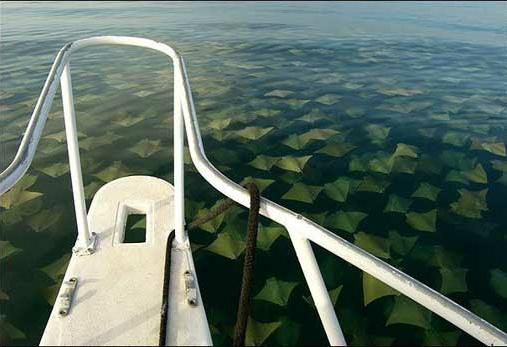 | |
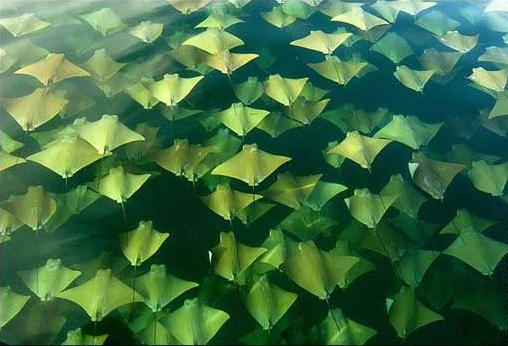 | |
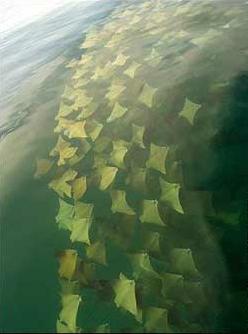 | 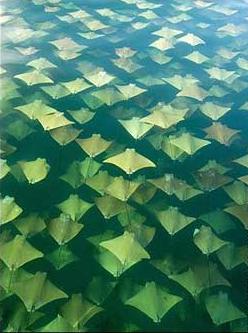 |
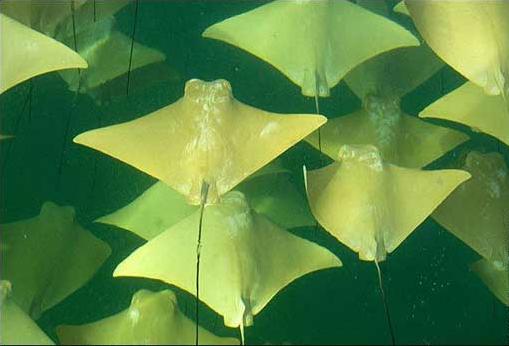 | |
Don't forget to share this with others! Let your friends enjoy the beauty of nature, too!
Origins: Some of the images shown above are reminiscent of
western Florida to the Yucatan in Mexico. Cownose rays have poisonous stingers, but even in large groups they're shy and not threatening. In 1608, Captain John Smith, an East Coast settler and explorer, learned about the nature of a cownose's sting. While Smith was spearing a ray with his sword near the Rappahannock River, the ray defended itself by stinging Smith in the shoulder. The pain was so terrible that the crew were convinced Smith was dying, so they dug a grave for him. But John Smith overcame the pain and felt well enough that evening to eat the ray for supper. The place where this happened is still known as Stingray Point. As this ray swims through the ocean, its wingtips often break the surface, resembling the dorsal fin of a shark, which sometimes causes undue alarm for swimmers and divers. Occasionally, they jump out of the water and land with a loud smack, a behavior thought to be a territorial display.
Cownose rays are known for their long migrations in large schools. They are strong swimmers, able to cover long distances. In the Atlantic Ocean, their migration is northward in the late spring and southward in the late fall. The population in the Gulf of Mexico migrates in schools of as many as
The above-displayed pictures of rays captured during one such migration were taken in the Gulf of Mexico by Italian photographer
Later I learned that they migrate 10,000 at a time and are found in the warm currents from Brazil all the way to southern New England. Passive creatures, they can live until about As quickly as they appeared that magic day, the migrating rays disappeared. I felt very fortunate to experience something so beautiful.
We were motoring around Holbox Island in the Gulf of Mexico, trying to find whale sharks so we could snorkel with them and photograph them. It was June. I was searching the horizon when I spotted this astonishing "wave" of cownose rays. We turned the boat towards the school, turned off the engine, and watched them move past us. There were thousands! They were swimming on the surface, and deep down, and all going in the same direction. They looked like beautiful leaves moving softly and gently by the wind.
The migrating ray photographs can also be found in the Marine Life section of Sandra Critelli's web portfolio.
Last updated: 2 June 2012
